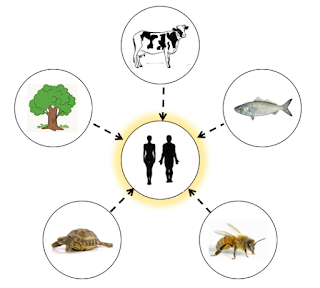Framing for care and engagement (Part III): Nature is not a resource
Photo by Boris Smokrovic on Unsplash
By Rodrigo Cáceres
In Part II of this post, we talked about what frames are and their defining characteristics. We discussed specifically the frame "Nature is a collection of resources" and its political consequences in terms of objectifying living beings and in terms of giving meaning to concrete destructive practices of "resource extraction". In sum, we could conclude that this frame is antagonistic with a respect and appreciation of Life on Earth.
So, what should we do about this frame? Well, the obvious answer is that it should stop being employed. However, since it is a frame that is ingrained in modern cultures, this fight must be led at least at two different levels. The first level is (i) undermining the frame, and it is precisely what we are doing in these essays. Namely, we are putting in perspective that the frame "Nature is a collection of resources" is not the definitive paradigm of reality nor a neutral way of understanding nature. It is just one frame amongst other frames for understanding Nature and how we should treat it. In simple words, it is just a story we have been told over and over. And it is a story that gives meaning to practices of ecological destruction and objectification of life on Earth.
The second level is simply the rejection of the frame. We should simply refuse that nature is framed as a resource to be exploited. This language should be ruled out as illegitimate, immoral and as reinforcing the values that are at the root of the current ecological crisis. So it is something that we should overcome, not entrench. Whenever a person or a group of people activate the frame of "Nature is a collection of resources" (particularly economists and politicians) and use its respective concepts, rejection can be immediate.
If you are, for example, a student in an economics/business degree, most certainly your teachers will be using this frame when speaking about Nature. In this case, you can easily serve yourself of the arguments we have built in the preceding posts to show the destructive consequences of this frame and demand for alternative ones.
If you are, for example, a student in an economics/business degree, most certainly your teachers will be using this frame when speaking about Nature. In this case, you can easily serve yourself of the arguments we have built in the preceding posts to show the destructive consequences of this frame and demand for alternative ones.
This kind of rejection and ideological incompatibility is rendered beautifully in an ethnographic scene presented by Neera Singh in a local community in Odisha, India. This community had developed a deep bond with the local forest and created a frame of "the forest is our child". As you might expect, this frame proved to be incompatible with the one embodied by the state Forest Department, the frame "the forest is a resource". In their own words, "the Forest Department sees forests as a crop, and models forest-management on those lines" (Singh, 2013, p.195). Later on, in one of the village discussions taking place between both parties, "an old man stormed out of the room in protest. Before leaving he said, ‘‘We have protected this forest as a child. Now you are discussing who will get what part [of the child].’’"(Singh, 2013, p.196).
We can readily see that the conflict happens at a very fundamental level, concerning a radical difference of convictions about what the forest really is: a child or a resource. As we argued in part II of this post, both frames are equally valid and we can only judge frames in terms of moral values. The "forest is resource" frame was already described as objectifying and destructive. Moreover, within the "forest is resource" frame all emotional and aesthetic attachments to the forest are ruled out as a possibility; they are left outside the frame, making them seem nonsensical and absurd.
Contrarily, the "forest is child" frame is a fundamentally caring, loving and protecting frame. It treats the forest as family, as an embodied living entity that deserves respect and is to be protected and taken care of. This frame is thus bursting with emotions and willingness to nurture a permanent reciprocal relationship with the forest. A further testimony by one of the leaders of this community shows how this bond gets more and more intensified in time, up to the point of becoming unconditional:
Contrarily, the "forest is child" frame is a fundamentally caring, loving and protecting frame. It treats the forest as family, as an embodied living entity that deserves respect and is to be protected and taken care of. This frame is thus bursting with emotions and willingness to nurture a permanent reciprocal relationship with the forest. A further testimony by one of the leaders of this community shows how this bond gets more and more intensified in time, up to the point of becoming unconditional:
Now, this [forest protection] has become a passion, an addiction. Even on getting beaten-up or crushed, we won’t leave the forest.
Certainly, it is outstanding how this emotional bond created within the "forest is child" frame leads even to the willingness to put your own physical integrity at stake to defend the forest.
It might seem evident by now that when we are within the "forest is child" frame, exploitative relations to the forest become immoral, treacherous and disrespectful; they are situated outside of the frame, making them seem nonsensical and absurd. A child is something that you protect and deeply care for, and not something that you exploit and destroy.
It might seem evident by now that when we are within the "forest is child" frame, exploitative relations to the forest become immoral, treacherous and disrespectful; they are situated outside of the frame, making them seem nonsensical and absurd. A child is something that you protect and deeply care for, and not something that you exploit and destroy.
References
Singh, N. M. (2013). The affective labor of growing forests and the becoming of environmental subjects: Rethinking environmentality in Odisha, India. Geoforum, 47, 189-198.





Comments
Post a Comment